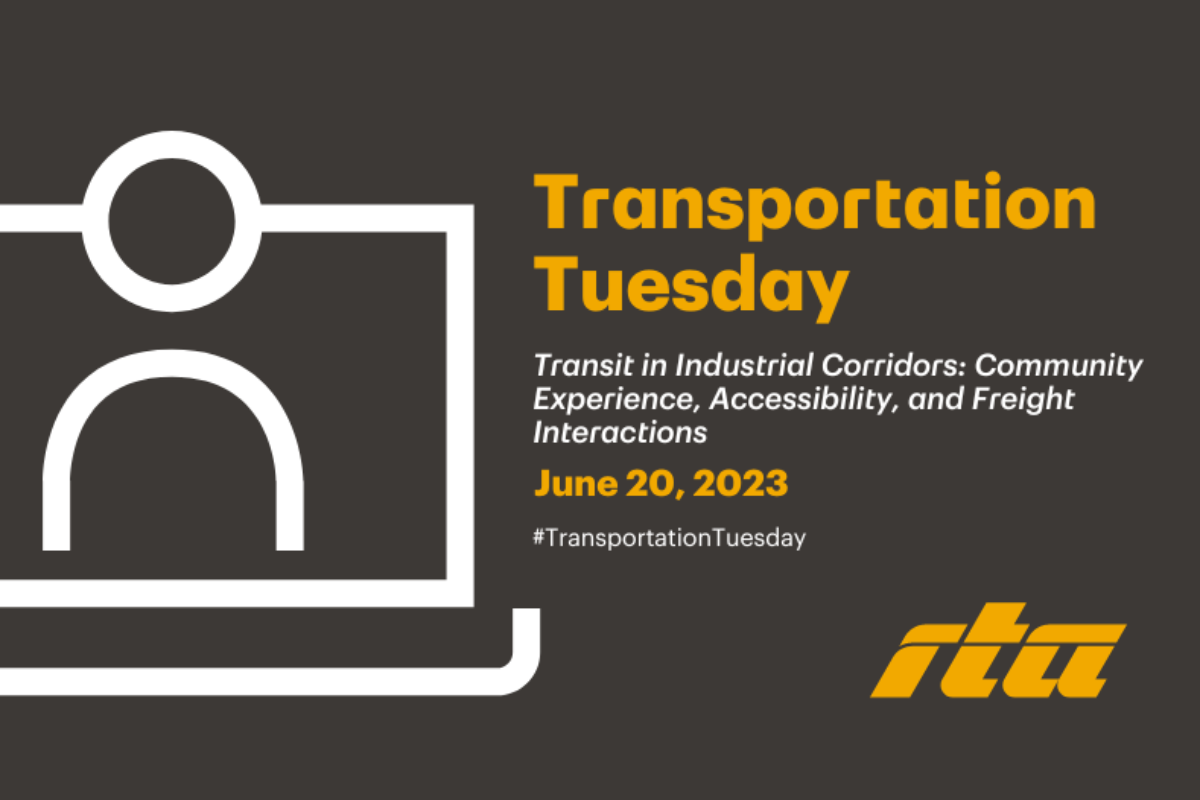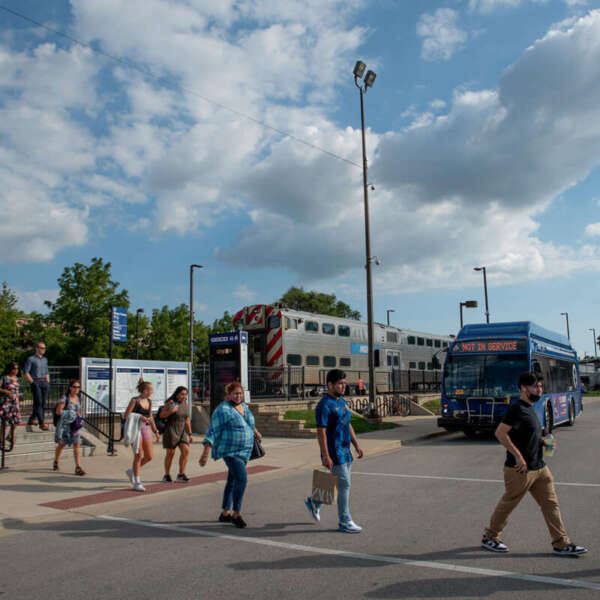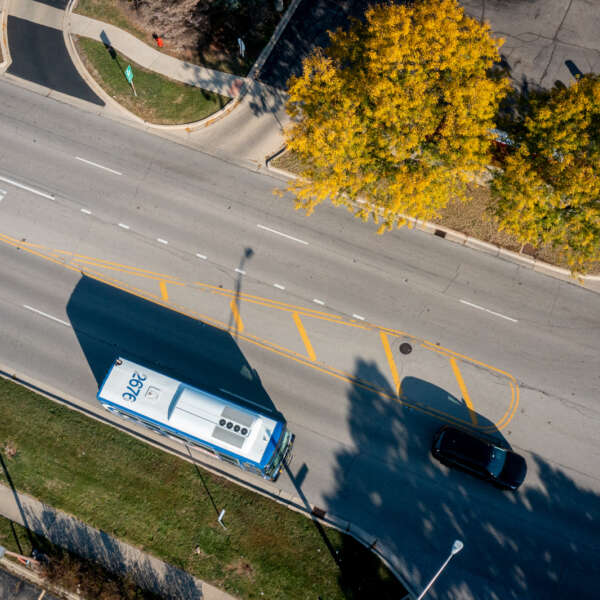Transportation Tuesday recap: Transit in Industrial Corridors: Community Experience, Accessibility, and Freight Interactions
June 21, 2023
June 21, 2023

Transit and freight movement are two quintessential aspects of Chicago’s legacy, present, and future. Industrial corridors, however, are not equitably distributed across neighborhoods. Often, people experiencing low incomes and communities of color are most exposed to negative impacts such as reduced pedestrian accessibility and increased air and noise pollution. These impacts are even more profound considering that such neighborhoods generally have a high proportion of residents who rely on transit for their daily transportation needs. At the same time, industrial corridors are major job centers that provide a benefit to the region’s economy and people employed in that sector.
This year’s penultimate Transportation Tuesday webinar explored the interactions between freight vehicles and transit from both an infrastructure and community impact perspective, featuring guest speakers from Little Village Environmental Justice Organization (LVEJO), Sam Schwartz Consulting, the Chicago Department of Transportation (CDOT), and Pace Suburban Bus.
Moderator Alex Waltz, RTA Senior Planner in the Local Planning division, moderated the roundtable discussion by presenting a series of questions before the panelists, followed by audience Q&A. The questions centered on unpacking the issues surrounding industrial corridors and the effects of freight trucks on residents and their ability to access transit services.
The panelists unanimously agreed that truck traffic is a growing concern. José Acosta-Córdova, Senior Transportation Policy Analyst for LVEJO, explained that trucks harm residents in communities adjacent to industrial land uses by emitting dangerous amounts of pollution into the air and by making it difficult to use and access public transportation due to long crossing distances and limited pedestrian facilities, both of which are common features of roadways designed to accommodate large trucks. Katherine Nickele, Transportation Planner at Sam Schwartz Consulting, elaborated that walking on sidewalks alongside main truck routes raises several safety, health, and comfort concerns for pedestrians, often discouraging them from using public transit in these neighborhoods.
David Tomzik, Planning Program Manager at Pace, said that in addition to walking, even driving in industrial corridors can be difficult because of the effects that truck traffic exerts on other road users. He explained that maneuvering around trucks can be difficult, especially for buses, making transit routes unreliable in these communities. Jeffrey Sriver, Director of Planning and Programming at CDOT, pointed out that trucks are only getting larger, longer, and heavier, creating instant negative externalities for anyone using the roads. “It is a high stress environment. Even in the best case, it diminishes the attractiveness,” said Sriver.
In exploring potential solutions to the challenges surrounding mobility in industrial corridors, roadway design was one of the strategic methods discussed by the panelists. Generally, the panelists agreed that roadways should provide more space and facilities for pedestrians, bicyclists, and transit riders, especially along transit corridors. The panelists agreed that roadway design requires making decisions about inherent trade-offs among treatments that will accommodate different road users. The panelists also noted that the current challenges facing pedestrians along industrial corridors are the result of previous decisions to design roadways with large lanes, wide turning radii, etc. to accommodate larger vehicles. The panelists also felt that Complete Streets policies could be used to help accelerate the provision of sidewalks and bikeways along industrial corridors, which could improve mobility for residents, expand travel options, and improve safety and comfort for existing bicyclists.
Nickele further explained that walking routes from transit stops to places of employment are frequently lacking sidewalks, require traversing large empty parking lots, and do not include adjacent street trees. These road design components work in concert to discourage people from taking transit, further eroding interest in using transit for transportation. As Nickele said: “Roadway design priorities determine the tradeoff of who [the street] is for. Planners need to plan how to discourage truckers and drivers from certain streets but encourage pedestrians to go on others.”
Although the bulk of the discussion was focused on general concepts and themes, a current RTA Community Planning project was referenced during the webinar. Since 2021, the RTA has been assisting CDOT to determine a course of action for improving mobility along 31st Street from Sacramento Avenue to the city limits in Little Village. This corridor is subject to high volumes of truck travel and is served by CTA Bus Route 35. Acosta-Córdova said that the data of travel trends and traveler demographics in this study area determined that industrial corridors most impact people of color and low-income communities. He stated that because roadway design tends to prioritize trucks and shipment facilities over pedestrians, there are very few residents in the area wanting to walk, bicycle, and/or use public transportation. “Our communities are overwhelmed with truck traffic and issues that come with it,” said Córdova.
The panelists noted that there is no “silver-bullet" to solve existing challenges in industrial corridors, but through the collaboration of local planners and elected officials at all levels, streets could be redeveloped to be safer and more walkable to further prioritize pedestrians and increase the use of public transportation.
“It is important to develop clean corridors and encourage the area to prepare on how to develop to support transit,” said Tomzik.
Transportation Tuesday takes place every Tuesday in June. The webinars are free, but registration is required. Learn more about future events and register to attend here.
Subscribe to our Newsletter
Related Articles
 Transit station activation in Uptown brings positive presence to Broadway bus route with weekly outdoor yoga class
Transit station activation in Uptown brings positive presence to Broadway bus route with weekly outdoor yoga class
On Friday mornings now through the end of the year, CTA #36 and #81 bus riders and Red Line passengers through the Uptown neighborhood of Chicago may catch a...
July 25, 2024 Join the RTA Transit is the Answer Coalition to discuss possible reforms to improve service and accountability for riders
Join the RTA Transit is the Answer Coalition to discuss possible reforms to improve service and accountability for riders
Following the introduction of legislation that proposes changes to how the Chicago region’s transit agencies are organized, the RTA continues to lead convers...
July 15, 2024 RTA releases new fare equity report, recommending fully funding and expanding reduced fare programs
RTA releases new fare equity report, recommending fully funding and expanding reduced fare programs
A new report released by the RTA in July, Building a More Equitable Fare Structure for Public Transit in the Chicago Region, recommends that the state legisl...
July 11, 2024 Homewood, Richton Park adopt transit-oriented development plans funded through RTA Community Planning program
Homewood, Richton Park adopt transit-oriented development plans funded through RTA Community Planning program
This spring, transit-oriented development (TOD) plans were adopted by the villages of Homewood and Richton Park that will make these communities more transit...
July 11, 2024 Good news: Regional transit ridership reaches new high as CTA, Metra, and Pace increase service, offer new fare products
Good news: Regional transit ridership reaches new high as CTA, Metra, and Pace increase service, offer new fare products
Ridership across Chicago’s transit system has continued to increase, with May 2024 seeing the highest ridership levels since 2019 for CTA, Metra, and Pace. T...
June 28, 2024 Legislative Update: Lawmakers pass state budget, action on transit funding still needed ahead of fiscal cliff
Legislative Update: Lawmakers pass state budget, action on transit funding still needed ahead of fiscal cliff
The Illinois General Assembly adjourned this year’s spring legislative session after passing an overall $53.1 billion budget for State Fiscal Year (SFY) 2025...
June 27, 2024